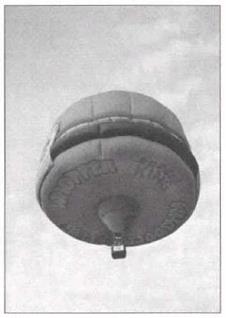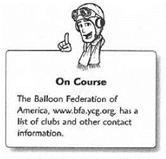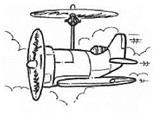Champagne and Propane
|
By the Book In a sport dominated by tradition, one of the most stunning, both for pilots and for spectators, is the mass ascension. As its name suggests, the mass ascension involves a large number of balloons inflating and lifting off together into the air. It’s a remarkable sight and an equally impressive sound as dozens of powerful propane burners ignite. |
The credit for ballooning’s “takeoff" in recent years goes in part to a group of hardy aficionados who gave it a spark of life and a splash of color. In 1972, the first gathering of 13 balloons lifted off from Coronado Center shopping plaza in uptown Albuquerque. The pilots who made that mass ascension certainly had no inkling that what they were starting would become the Albuquerque International Balloon Fiesta, the greatest pilgrimage for hot-air balloonists around the world.
Now, nearly 30 years later, the Albuquerque event has turned into a nine-day extravaganza that rivals the largest air shows for powered airplanes in terms of size and impact among balloon pilots and fanciers. It has become a worldwide draw, attracting no less than onefifth of all the balloons in the world.
Of course, where there’s one festival, there’s usually another. In the case of ballooning there are other major annual events that bring out hundreds of balloons and thousands of spectators.
In Indianola, Iowa, at the National Balloon Classic each summer, locals play host to a hundred balloons or more for a week. Every day, balloonists fire up their burners for two flights, one in the early morning and one in the early evening, when the winds are lightest and least treacherous. In the meantime, the festival resembles a county fair with performances by bands, road races, and a host of other activities to keep the family entertained.
|
|
Mass ascensions, in which a number of balloons
launch at the same time, might
be one of the most beautiful sights in aviation. Though
the scene looks chaotic, pilots and crews are careful to
stay safe.
(Allen Matheson, Photohome. com)
|
|
Plane Talk
One of the most spectacular events at any gathering of balloonists doesn’t take place in the air at all, but on the ground. It’s the "glow," and it begins in the late dusk or in the pitch black of night when dozens of balloonists light up the dark with the multicolored glow of burner flames inside the colorful craft. The key to getting the most light out of the propane flames is to adjust the burners to produce a flame that is not very efficient at producing heat, but is quite efficient at producing light. The night sky, lit up with a thousand colors amid the roar of butane burners, is an experience you’ll never forget.
The popularity of annual days-long events like the Albuquerque International Balloon Fiesta and the National Balloon Classic is a sign of the increasing popularity of perhaps the most civilized of all forms of aviation. After all, where else does each flight come with a requirement to toast a successful landing with a tipple of champagne? Of course, balloon pilots are certified by the Federal Aviation Administration just like airplane pilots, so by law they can’t take a nip of the bubbly until the flight is over. But I still say balloon pilots know how to celebrate a successful flight better than any other flyer. As balloonists love to say, hot-air ballooning is “powered by propane and champagne.”
Imagination and Technology
|
On Course The combination of champagne and ballooning is a centuries-old French tradition. It probably originated from pilots wanting something nice to offer irate farmers and land owners if they were forced to land in the middle of a field or a backyard. ■ ■’— ,,, — |
|
On Course Some specie! balloon shapes take advantage of the hot-air balloon’s natural shape. The three best examples I’ve seen are the design in the shape of a golf ball mounted on a tee. an ice-cream cone, and a giant iightbulb. |
|
|
Imagination and technology converge in ballooning as in no other aviation sport. Thanks to computers and specialized software, there’s almost no limit to the variety of designs of modern hot-air balloons.
Take the 1999 Albuquerque International Balloon Fiesta as an example. The balloons came in the shape of an enormous bald eagle, a huge, pink Energizer Bunny, a Mountain Dew can, a La-Z-Boy recliner, and even a Harley-Davidson motorcycle. (Do you get a sense that this sport, like others, has become a trifle commercialized?)
The 1999 National Balloon Classic featured a giant Burger King Whopper and a sky-high mock-up of a bottle of Mrs. Butterworth’s syrup.
There were also plenty of balloons without noticeable commercial connections, though these are often sponsored by a friendly local business looking for a little publicity. For example, there are giant eagles and parrots, a Canadian Mountie on his horse, a race car, and—my personal favorite—the almost life-size space shuttle.
Special shapes help promote ballooning by bringing commercial support to an expensive sport, making it easier for pilots and crews to attend more events. They provide a dazzling spectacle as they cross the countryside. And they help promote the sport by bringing millions of delighted spectators out to balloon events each year!
|
One of the most entertaining parts of ballooning, both for pilots and spectators, is the dazzling variety of balloon designs that resemble everything from bottles of pancake syrup to hamburgers like this one. (Allen Matheson, Photohome. com) |
|
What Will It Cost?
|
Ballooning is among the easiest and least expensive forms of aviation you can get hooked on. If you decide to join with a few friends or family members to share the costs, ballooning can be downright cheap—well, cheap compared to the cost of airplane flying.
If you want to test your reaction to going aloft in a hot-air balloon, you can probably find a local ballooning flight school that, for about $150 or less, will take you on a flight and let you experience the feeling firsthand.
Ballooning schools are not nearly as common as training centers for other forms of aviation, except in some of the traditional ballooning hot spots such as New Mexico and other Southwestern states. But some searching on the Internet or asking around your local airport will turn up some leads.
|
Turbulence Balloon pilots are certified by the Federal Aviation Administration, just like airplane pilots. They train and study for hours in order to fly their craft in a way that is safe to passengers and to people and property on the ground. And because they are so good at what they do, they make it look easy. But never think you can be a safe balloon pilot, or a pilot of any aircraft, for that matter, without expert training and plenty of hard work. I J |
Once you’re hooked on hot-air ballooning, you may start thinking about buying your own rig. Plan on paying between $15,000 and $35,000 for a new balloon, including envelope, gondola, instruments, burners, and fuel tanks. Insurance will add another $2,000 or so per year. Another cost savings over airplanes is in storage. For a balloon, you aren’t compelled to rent a hangar at a local airport or pay storage fees—just put the gondola and the rolled-up envelope in your garage.
You’ll need a private pilot certificate to fly a balloon. Lessons you’ll need in order to earn your private pilot’s certificate will add about $1,500 to your expenses provided you already have your own balloon and equipment. If you use the equipment provided by a flight school, the cost jumps to almost $2,500. Your instruction will involve almost 10 hours of flight training and another 10 hours of ground school. Most flight schools will include training materials in the price, but expect to add another $200 or more to pay an examiner’s fee once it’s time to take your final flight and ground exams. Yes, once again we see that aviation can be an expensive hobby.
Happy ballooning!
The Least You Need to Know
>■ Archimedes’ principle—that a body immersed in fluid loses weight equal to the weight of the amount of fluid it displaces—explains the buoyancy of hot-air balloons.
► From takeoff to landing and recovery, ballooning is a team effort
► A balloon pilot must have a thorough understanding of wind patterns.
^ Turn to Albuquerque or the other annual balloon festivals for the closest look at the sport
Chapter 12
Hybrids, Oddities, and Curiosities
|
|
In This Chapter
>■ Blimps: a closer look
>■ Gyroplanes: making a comeback to former glory >■ The Harrier jump jet: helicopter or airplane?
>■ Rozier balloons: around the world in 19 days
In Part 2, “The Thrill of Flight,” we’ve looked at the most common flying machines in which people take to the skies. But the dream of flight has not been realized only in the airplane, the helicopter, the glider, and the hot-air balloon. Other flying machines, though too impractical for general recreational use, enable people to accomplish incredible feats, whether it be flying around the world nonstop or just getting a really, really cool view of a football game.
Perhaps the best way to end this part of the book is to take a look at a few of these flying machines.























